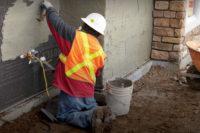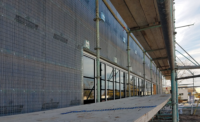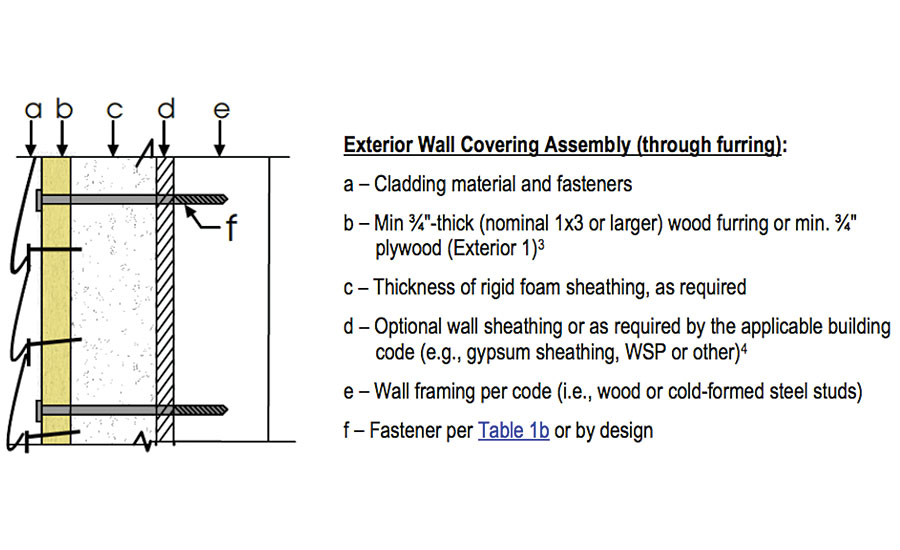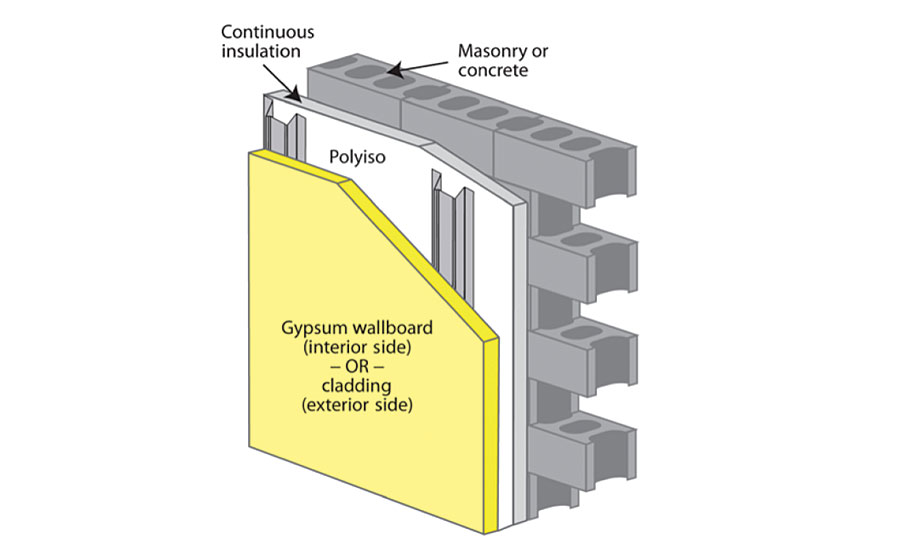What’s Going on in the Lath & Plaster Industry?


Illustration of Exterior Wall Covering Assembly Components (through furring)
Note: Wall sheathing layer “d” is optional unless required by the applicable building code
Photo Credit: DRR No. 1303-04 Attachment of Exterior Wall Covering Through FPIS to Wood or Steel Wall Framing

Furring Minimum Fastening Requirements for Application Over Foam Plastic Insulating Sheathing to Support Cladding System Weight & Resist Wind Pressure
Photo Credit: DRR No. 1303-04 Attachment of Exterior Wall Covering Through FPIS to Wood or Steel Wall Framing

Furring Minimum Fastening Requirements for Application Over Foam Plastic Insulating Sheathing to Support Cladding System Weight & Resist Wind Pressure
Photo Credit: DRR No. 1303-04 Attachment of Exterior Wall Covering Through FPIS to Wood or Steel Wall Framing

Continuous insulation is defined as “insulation that is continuous across all structural members without thermal bridges other than fasteners and service openings. It is installed on the interior [or] exterior, or is integral to any opaque surface of the building envelope.”





To get an understanding of what’s happening in the lath and plaster industry is largely a function of being in-tune of what’s going on with ASTM committee C11 on Gypsum and Related Building Materials and Systems. The committee, with a current membership of more than 380, has jurisdiction of 57 standards, covers specifications and guides for gypsum products and gypsum board, metal lath, studs, fasteners and related metal products, as well as practices for the application of stucco and EIFS products.
The C-11 committee supports two separate task groups: ASTM C-926-16a (Standard Specification for Application of Portland Cement-Based Plaster) and ASTM C-1063-16a (Standard Specification for Installation of Lathing and Furring to Receive Interior and Exterior Portland Cement-Based Plaster).
So, to get a picture of the latest issues being discussed, let’s review the two task groups of ASTM C-11.03. One important point to note, these ASTM standards are now current to 2016, with the extension on both standards listed as “16a,” meaning the current publication for most recent changes is 2016.
ASTM C1063 recently passed balloted items include:
Clean Accessories:
- Section 6.2.2 Accessories had the following verbiage added: Accessories shall be free of deleterious amounts of rust, oil, or other foreign matter, which could cause bond failure or unsightly discoloration.
Use of Adhesives to Attach Accessories:
- Section 7.11.1.2 Alternatively, secure accessories with perforated or expanded flanges directly to solid plaster bases (as defined by 3.2.25 of ASTM C926) by means of a materials compatible, exterior, gun-grade, construction adhesive applied in nominal 1inch (25.4 mm) dabs spaced at minimum fastening intervals per 7.11.1.1 or in a semi-continuous bead between the solid base and the unperforated portion of the flange. Expandable foam adhesives shall be prohibited.
Contaminated Accessories:
- Verbiage found in C926 (Sect. 5.1) was balloted to “port over” to C-1063, where it belongs.
Addition to Section 7 – Installation:
- Section 7.11.1 General accessories shall be installed prior to the application of plaster; therefore, their type, depth, and location shall be included in the contract documents by the design authority. All metal accessories shall be installed in such a manner than that flanges and clips provided for their attachment are completely embedded in the plaster.
Control Joint Framing:
- A ballot item was submitted (as in the past) but again, could not find agreement within the committee’s nation-wide representation; consequently it was withdrawn. A C-1063 Workshop on Control Joint Installation Workshop #2 in Orlando, Nov. 14, 2016, 4 hrs., to discuss and resolve issues of this ballot item.
ASTM C-926 recently passed the following ballot item:
Section 7 – Application:
- General – Section 7.1.1. The addition of the word “hand” before trowel, to include use of the tool in the applicator’s hand. That wording looks like this:
“Portland cement plaster shall be applied by hand or machine to the nominal thickness specified in Table 4. The nominal values expressed in Table 4 represent neither a maximum nor minimum value. They consider the inherent variation of thickness due to the nature of the application process, and the allowable variation of the substrate and the finished plane of the plaster...”
While there were other ballot items voted on for ASTM C-926, those ballot items received objection (i.e. negative votes) that were found “persuasive” by the C-11.03 task group and C-11 main committee. For this half-year voting cycle, only one new item will be included into the C-926 Standard. However, many other updates have been included into the standard in the last two years. So, having copies of the most current ASTM standards is important to understand and install to the most current specifications. These standards can be sourced and purchased at www.astm.org.
The Elephant in the Room
What the ASTM committee has yet to address is the need for continuous insulation behind stucco.
Continuous Insulation is defined as “insulation that is continuous across all structural members without thermal bridges other than fasteners and service openings. It is installed on the interior [or] exterior, or is integral to any opaque surface of the building envelope.”
Insulation can be used with a variety of wall structural systems and cladding materials such as cement board, PC stucco, wood lap, brick veneer, stone, and vinyl siding. Furthermore, CI can be placed on the interior or exterior side of the wall with proper consideration of climate-dependent moisture vapor control code requirements. For example, it is common to place CI on the inside face of foundation walls and also above-grade masonry walls, which is considered a typical practice in Florida where the exterior masonry wall face is parge-coated. Finally, it is possible to use CI alone to meet energy code without any cavity insulation for the ultimate “warm-wall” design.
The approach to accomplishing this design seems to be focused on applying lath and plaster to the surface of the insulation, with accessories:
Placed on top of the Insulation (EPS, XPS, Polyisocyanurate (ISO board) using conventional accessories installed today.
OR -
Developing new accessories wide enough to be placed behind the insulation and encompass the stucco cladding as well; approx. 2¾- to 5¾-inch wide grounds, depending on the type of insulation selected. These accessories (casing beads, control joints, weep screeds) aren’t manufactured in metal today and will require quite an investment to produce them.
In the aforementioned design scenarios, installers attach the metal lath in one of two ways:
Z-furring that places the insulation in-between the furring, creating a “sandwich” effect with the furring and insulation. While this is easily assembled, it does include minimal thermal transmission loss due to the Z-furring conduit. But, the furring provides a nice base to attach the lathing system. The direction of the furring will determine the direction of the lath (rolls or sheets) on the wall; always placed perpendicular to the framing (See ASTM C-1063, Section 7.10 Application of Metal Plaster Bases):
- Section 7.10.1.3 Lath shall be applied with the long dimension at right angles to the supports, unless otherwise specified.
- Section 7.10.1.4 Ends of adjoining plaster bases shall be staggered.
Extra-long fasteners that are substantially larger and heavier than those used today, to penetrate and extend through the insulation system, the sheathing and into the framing members (wood or metal). These fasteners are believed to have less thermal transmission than the Z-furring, but that reduction is not yet defined. However, there has been a study published by the Foam Sheathing Coalition (FSC.org) dated December 2011. This document outlines a step-by-step approach for designing attachments for cladding materials through foam sheathing and was adopted by the New York State Research & Development Authority for a method of compliance to IECC—Federal Energy Standards. Many design authorities are using this published document to size the fasteners and follow the spacing outlined in ASTM C-1063 to attach the metal lath (sheet or rolls) to the surface of the continuous insulation.
In both approaches described above, the designer will still have to address the weather barrier and flashing systems to collect and drain to the outside of the cladding system. This approach has not yet been address and solved outside a few proprietary systems.
Need for Consensus Efforts in Advocacy
With ever-changing industry guidelines, competition from other cladding systems and the miseducation of installers, it is imperative our industry advocates and promotes complying with ASTM standards for the advancement of lath and plaster. For the last several years, I have participated in the Florida Lath & Plaster Bureau and can say it’s a microcosm of the type of collaboration needed at a national scale, among those who have a vested interest in the growth and development of hard-coat stucco. This non-profit trade group has been delivering on its mission to:
“… preserve, promote and positively affect the quality of traditional Portland Cement-based Plastering in Florida by providing technical support and education for Contractors, Sub-contractors, Home Builders, Building Officials, Architects, Engineers, and producers; as well as to provide industry expertise to the development of Building Codes and Standards.”
How does the FLAPB do this? They are willing to get the stakeholders around the table; all those who have an interest in the stucco business, including:
- Cement Manufacturers, Lath and Accessories Manufacturers, EIFS & Coating Manufacturers, Weather Barrier Representatives
- Stucco Contractors, Building Envelope Consultants and Building Code Officials
This group meets quarterly in Orlando to discuss ASTM-related work on the standards, issues being seen in the field and possible ways to resolve them. The FLAPB developed a website (www.flapb.com) where they issue technical bulletins too; accessible by the A&E as well as contracting community to utilize.
Other trade associations, such as the Western Wall & Ceiling Contractors Association (WWCCA), based in California, the Northwest Wall & Ceiling Bureau (NWCB) for Oregon, Washington & Western Canada and the Minnesota Lath & Plaster Bureau (MNLPB) have created similar programs but the FLAPB is unique in the fact that they include more facets of the wall cladding materials.
Building and design professionals need to stay up to-date on all applicable building codes and ASTM standards. Furthermore, the design community is looking for ways to solve these design problems and keep lath and plaster in their projects. Staying abreast of the ever-changing guidelines covered above will produce healthier, more stable and sustainable buildings and reduce callbacks. As an industry it is upon each of us to move the industry forward.
Looking for a reprint of this article?
From high-res PDFs to custom plaques, order your copy today!











